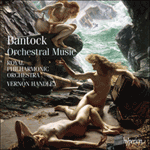
Welcome to Hyperion Records, an independent British classical label devoted to presenting high-quality recordings of music of all styles and from all periods from the twelfth century to the twenty-first.
Hyperion offers both CDs, and downloads in a number of formats. The site is also available in several languages.
Please use the dropdown buttons to set your preferred options, or use the checkbox to accept the defaults.

Bantock’s treatment of both songs is exemplary. Not only does he respect the integrity of the original air but he allows it to develop symphonically in a dazzling display of orchestral wizardry. Cuchullan’s Lament is cast as an heroic threnody—the main theme announced by a solo trumpet. Cuchullan (or Cuchullin, Cuchulain, one of Ireland’s great mythic heroes) had the misfortune to slay his own son, not recognizing him. In the original song, as in Bantock’s miniature tone poem, he keeps a death watch over the stricken youth:
Woe is me! my son a-keening!
Loud o’er the moor my wail-cry,
Clanging thy shield and flame-keen sword,
Who lieth asleep in cold death.
Equally evocative is Kishmul’s Galley, whose melody Bantock had already used to marvellous effect in the Hebridean Symphony:
High from the Ben-a-Hayich
On a day of days
Seaward I gazed,
Watching Kishmul’s galley sailing.
Again the melody, heard first on the horns, provides thematic material for the entire movement, which grows organically in a wild, sea-tossed vision of ancient heroes and heroic splendour.
from notes by Michael Hurd © 1992
Le traitement de ces deux chants par Bantock est exemplaire. Non seulement respecte-t-il l’intégrité de l’air original mais il lui permet de se développer symphoniquement dans un déploiement éblouissant de magie instrumentale. La Lamentation de Cuchullan est composée comme une lamentation héroïque—le thème principal annoncé par une seule trompette. Cuchullan (ou Cuchullin, Cuchulain, l’un des grands héros mythiques irlandais) eut le malheur de tuer son propre fils, ne l’ayant pas reconnu. Dans le chant original, comme dans le poème symphonique miniature de Bantock, il passe une veillée funèbre près du corps du jeune homme:
Woe is me! my son a-keening!
Loud o’er the moor my wail-cry,
Clanging thy shield and flame-keen sword,
Who lieth asleep in cold death.
Ô malheureux! je me lamente sur mon fils!
Bien haut par dessus la lande retentissent mes pleurs,
Tout en faisant résonner ton bouclier et ton épée tranchante comme la flamme,
Toi qui reposes dans la froide étreinte de la mort.
La Galère de Kishmul est tout aussi évocative; sa mélodie avait déjà été utilisée par Bantock dans la Symphonie des Hébrides:
High from the Ben-a-Hayich
On a day of days
Seaward I gazed,
Watching Kishmul’s galley sailing.
Du haut du Ben-a-Hayich
En ce jour mémorable,
Je contemplais la mer,
Et regardais voguer la galère de Kishmul.
De nouveau la mélodie, que l’on entend tout d’abord sur les cors, fournit le matériel thématique au mouvement tout entier, qui se développe fondamentalement dans une vision sauvage, ballottée par les flots, d’anciens héros et de splendeur héroïque.
extrait des notes rédigées par Michael Hurd © 1992
Français: Alain Midoux
Bantocks Umsetzung beider Lieder ist beispielhaft. Nicht nur achtet er darauf, daß das ursprüngliche Air unangetastet blenpibt, sondern er gestattet auch mit blendend zur Schau gestellter orchestraler Zauberkunst dessen sinfonische Weiterentwicklung. Cuchullan’s Lament ist als heroischer Threnos angelegt—dessen Hauptthema von einer Solotrompete verkündet wird. Cuchullan (auch Cuchullin oder Cuchulain, einer der großen mythischen Helden Irlands) hat das Pech, seinen eigenen Sohn niederzustrecken, den er nicht erkennt. Im Originallied wie in Bantocks kurzer Tondichtung hält er Totenwache bei dem verstorbenen Jüngling:
Woe is me! my son a-keening!
Loud o’er the moor my wail-cry,
Clanging thy shield and flame-keen sword,
Who lieth asleep in cold death.
Weh mir! Meinen Sohn bewein ich!
Laut übers Moor hallt mein Klageruf,
Laß ich klirren dein Schild und feuergehärtet Schwert,
Der du in kaltem Tod darniederliegst.
Gleichermaßen sinnträchtig ist Kishmul’s Galley, dessen Melodie Bantock bereits wunderbar effektvoll in der Hebriden-Sinfonie verwendet hatte:
High from the Ben-a-Hayich
On a day of days
Seaward I gazed,
Watching Kishmul’s galley sailing.
Vom Gipfel des Ben-a-Hayich
An einem einmalig schönen Tag
Blickt ich aufs Meer hinaus
Und sah Kishmuls Langboot segeln.
Wiederum liefert die Melodie, die zunächst von den Hörnern angestimmt wird, das thematische Material für die ganze Komposition, die organisch aus einer ungestümen meerumtosten Vision frühzeitlicher Helden und heroischer Pracht erwächst.
aus dem Begleittext von Michael Hurd © 1992
Deutsch: Anne Steeb/Bernd Müller
 Bantock: Orchestral Music Bantock: Orchestral Music‘Bantock's prodigious output as a composer … rested in the long grass for decades until Vernon Handley's Hyperion recordings revealed the many qu ... ‘What an achievement! Twenty-one late-romantic orchestral works in one box at mid-price or better. Bantock's lavish romanticism is superbly served by ...» More |

